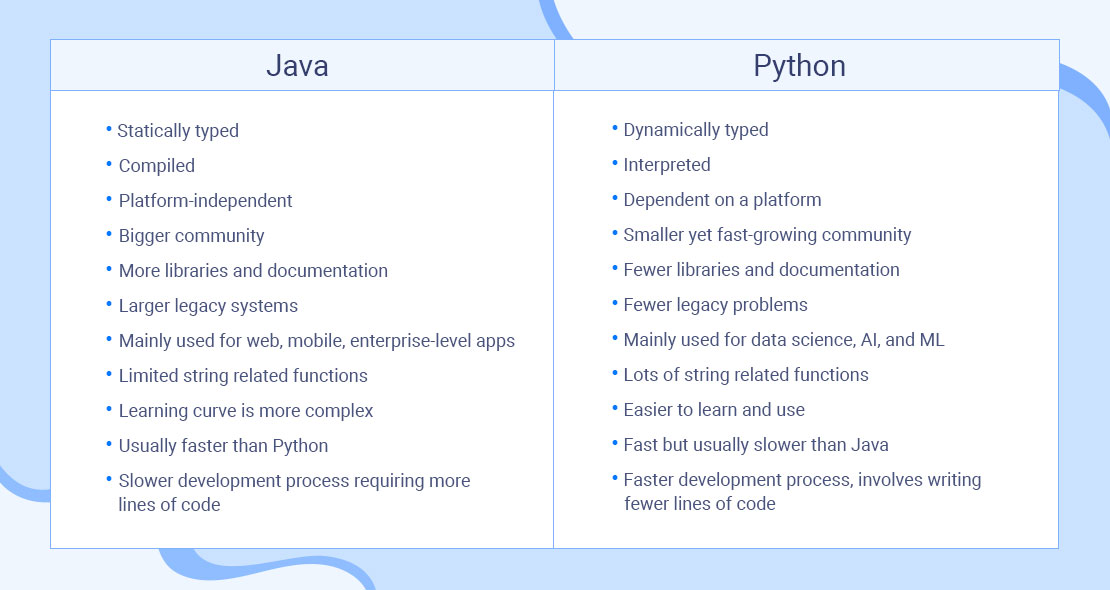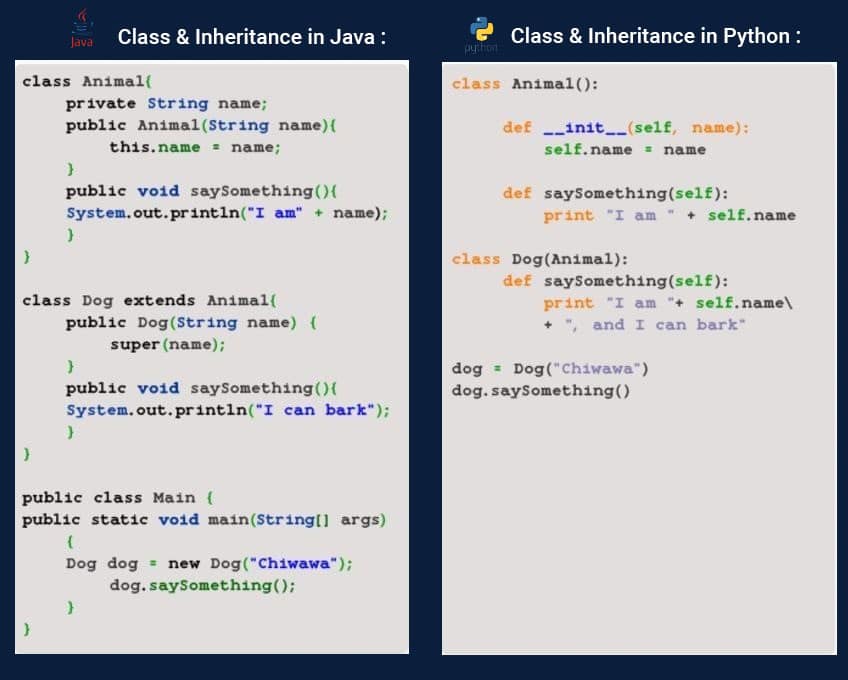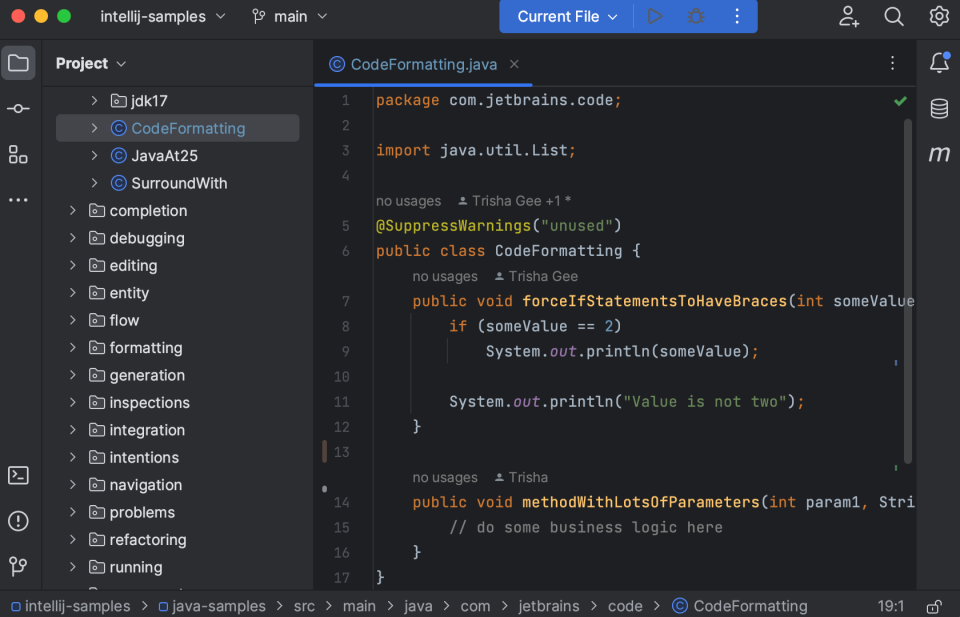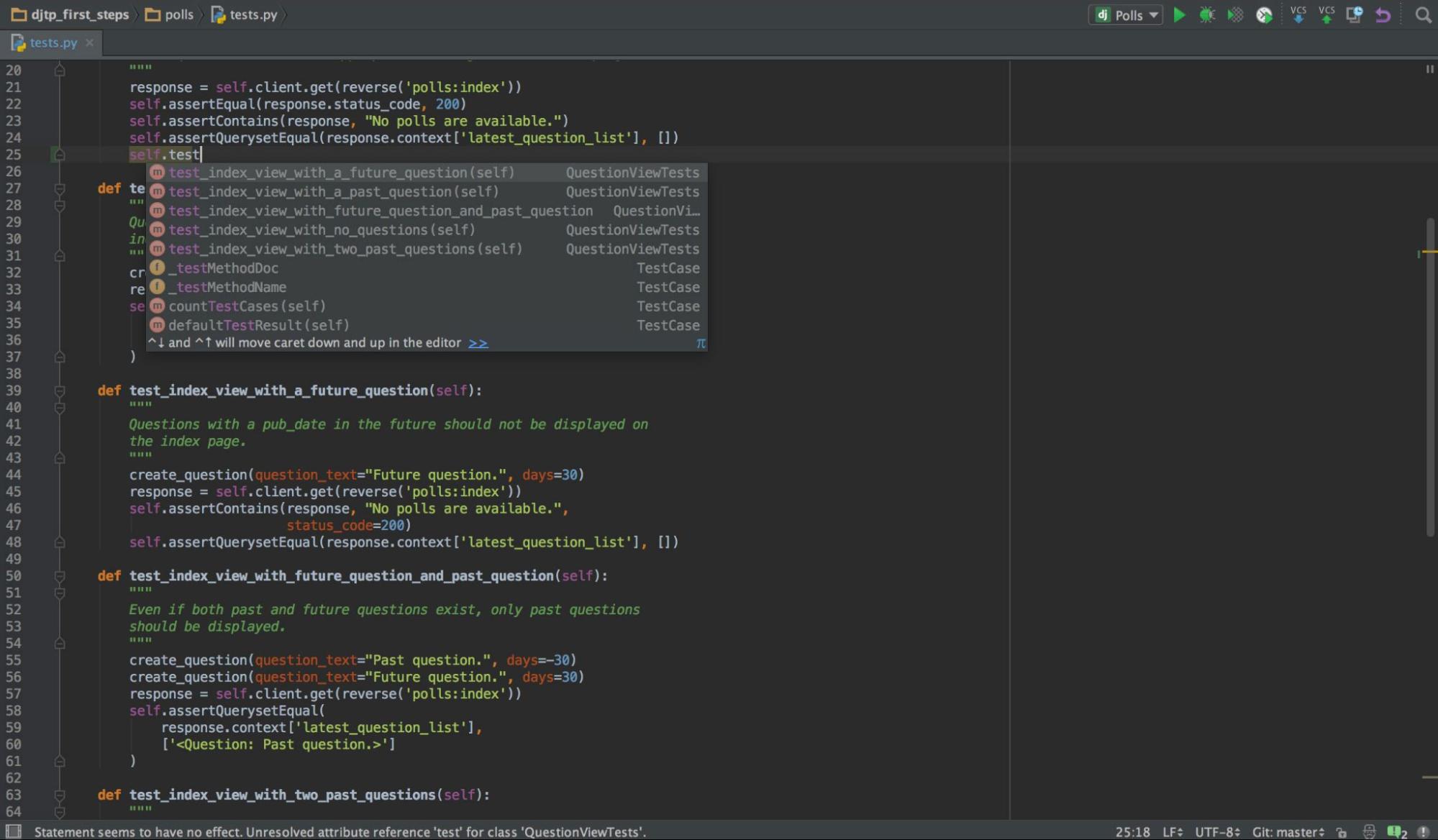Introduction
Programming languages are a core component of computer science and are essential for creating various applications. In recent years, Java and Python have become the most popular programming languages. Java has been around for a while and is, therefore, more popular than Python. Nevertheless, Python has now started to gain popularity due to its simplicity.
Both languages are developers’ favorites, providing a wide variety of libraries.
A question often asked is Java or Python, which is better for the future? Both are very popular and have their advantages and drawbacks. Python is straightforward to learn, easy to code, and has a large library. Java is more compatible and excels at creating games and apps for mobile devices. To better understand this, we will compare the two languages on different parameters to better understand this.
If you need help deciding which programming language would be a better fit for your project, Java or Python, read this article to better your understanding of both. Here, we shall look at the differences between them and see which suits your project.
Table of Contents
Difference Between Java and Python
Here is a table that briefs you about the primary differences between Java and Python. Have a look!
| Java | Python |
| Java is a compiled language. Any platform with a Java Virtual Machine (JVM) can run the compiled code because it is converted into bytecode. | A Python interpreter can run programs written in the interpreted computer language Python. |
| Java was created for class-based and object-oriented paradigms. | Python supports the functional, procedural, object-oriented, and imperative paradigms. |
| More time and effort are required for the developers to keep understandable Java code. | Python keeps the code brief, organized, and readable. |
| Java is a language with strong typing. It prevents the compiler from changing a variable’s data type unless the variable is type-casted. | Since Python is a dynamically typed language, declaring variables is unnecessary. The interpreter can recognize and modify the variable’s data type without declaring it. |
| Java is faster as all the types are assigned during compilation. | Python is slower because it uses an interpreter and assumes the types as it runs. |

Source: Scand
You may be wondering which is better, Java or Python? The following section covers different areas of dissimilarities between the two.
Language Features – Java and Python
Syntax and Readability
Java: Machine learning is a statically typed language with strict syntax rules. It requires semicolons (;) to separate statements and curly braces ({}) to define blocks of code. This can make the code more verbose, but it also creates a more structured approach. If you have enough coding knowledge and experience, feel free to work with Java.
Python: Machine learning is a dynamically typed language with simpler syntax rules. It uses whitespace indentation instead of braces, which leads to cleaner and more readable code. The syntax is closer to natural language and easier to learn than Java. If you are still figuring out your way through coding, Python is a better place to start.

Source: Cuelogic
Type System
Java: Java has a static type system, where the type of a value is known at compile time. This helps prevent type-related errors before the program is executed but may require more upfront planning.
Python: Python has a dynamic type system, where the type of a value is determined at runtime. This can make writing code faster and more flexible, although it can also lead to runtime errors that might have been caught with static typing.
Object-Oriented Programming
Java: Java is strictly an object-oriented programming (OOP) language, where everything revolves around the concept of objects and their interactions. Inheritance, polymorphism, and encapsulation are the three main OOP features supported in Java.
Python: Python supports multiple programming paradigms, including OOP. Python’s OOP capabilities include support for inheritance, polymorphism, and encapsulation but may be less enforced than in Java. You can write object-oriented code in Python if you prefer, but you aren’t required to do so.
Concurrency
Java: Java provides built-in support for multithreading and concurrency through the java.util.concurrent package, along with powerful synchronization primitives like monitors and locks. Java supports both parallelism (simultaneous execution) and concurrency (shared resource management).
Python: Python has limited native support for concurrency due to the Global Interpreter Lock (GIL), which allows only one thread to execute at a time. Although, the issue can be resolved by using more than one interpreter. Nevertheless, Python supports concurrency libraries like asyncio and multiprocessing, which help circumvent the GIL for specific use cases.
Error Handling
Java: Java handles errors through a robust exception-handling mechanism, which includes checked (compile-time errors) and unchecked exceptions (runtime errors). Checked exceptions must be explicitly caught or declared by the developers to be thrown or instantly fixed, enforcing good error-handling practices.
Python: Python uses exceptions for error handling but does not distinguish between checked and unchecked exceptions. In case of an error, Python normally stops and generates an error message. The flexible error-handling approach allows developers to catch and handle exceptions as needed without requiring them to declare exceptions in advance.
Performance and Scalability
Speed and Efficiency
Java is faster than Python as it is a compiled language, while Python is an interpreted language. Java code must be compiled before running, ensuring that errors are detected before the code is executed. Whereas Python code is directly executed without prior compilation, which can cause issues during runtime.
Memory Management
Java is better than Python in memory management. Java has a garbage collector that automatically removes objects that are no longer needed or have no references. Python also has a garbage collector but is not as efficient as Java’s.
Parallel Processing
Python is better than Java in parallel processing. Python has a module called “multiprocessing” that allows for parallel processing, while Java’s parallel processing capabilities are complex and require more lines of code.
Handling Large Datasets
Python is better than Java at handling large datasets. Python has libraries like NumPy and Pandas specifically designed for handling large datasets, while Java does not have a similar library.
Java is better suited for complex and large-scale applications, while Python is better for data analysis, scientific computing, and machine learning.
Use Cases and Industry Applications
Web Development
Java: Java is a popular choice for web development due to its extensive library support, scalability, and performance. It is used with frameworks like Servlet API, JDBC (Java Database Connectivity) API, and Java EE (Enterprise Edition) for building robust web applications.
Python: Python has gained popularity in web development because of its simplicity and the availability of frameworks like Django and Flask. These frameworks allow developers to create web applications quickly and efficiently.
Data Science and Machine Learning
Java: Java has several libraries available, such as Weka 3, Deeplearning4j, and MOA, JSAT, which can be utilized for data science and machine learning tasks. In fact, the Java Virtual Machine is one of the most widely used ML platforms as it enables developers to work with identical code across multiple platforms.
Python: Python is the go-to language for data science and machine learning due to its extensive ecosystem of libraries, like Pandas, OpenNN, NumPy, and Scikit-learn, as well as deep learning libraries, like TensorFlow and Keras. The programming language is widely used in building blockchain-based applications like smart contracts, cryptography, etc.
Mobile Application Development
Java: Java is used for multi-platform mobile app development; as most developers say, “With Java, write once, run everywhere.” Nevertheless, it is significantly used for Android app development due to its official support by Google in Android Studio, based on IntelliJ IDEA software.
Python: In comparison, Python is less widely used for mobile app development as it does not have pre-built mobile development capabilities; however, frameworks like Kivy, PyQt, and Beeware’s Toga library exist to create cross-platform mobile apps with Python.
Game Development
Java: Java is often used in game development for Android devices or games built on platforms like PC or consoles using engines such as libGDX, Litiengine, GreenLightning, Jbox2D, and JMonkeyEngine. Surprisingly, one of the most popular games, Minecraft, was written in Java!
Python: Python is used for game development, although its use is not as prominent as C++ (with DirectX and OpenGL) and Java. However, many game developers have successfully developed games using Python using libraries like Pygame, Pyglet, Kivy, Panda3D, and many more.
Enterprise Software Development
Java: Java has long been a common choice for enterprise software development due to its stability, scalability, security features, and ability to support large-scale systems. Especially with Java EE (Enterprise Edition), the complexity of building large-scale software applications is significantly reduced. The platform allows for easy, universal software deployment for multi-tier, server-centric applications.
Python: Python is increasingly adopted in enterprise contexts, particularly for smaller projects for task automation, data analysis, and rapid prototyping. However, Java remains the more established language for large-scale enterprise software development.
Tools and Ecosystem
Integrated Development Environments (IDEs)
Java and Python both have a wide range of IDEs to choose from. For Java, the most popular IDEs are Eclipse, IntelliJ IDEA, JDeveloper, and BlueJ. On the other hand, Python is often associated with IDLE, but it also has many other popular IDEs, such as Pycharm, Spyder, Visual Studio, and Jupyter.

Source: hacker.io

Source: JetBrains
Libraries and Frameworks
Java has many libraries and frameworks available for developers. Some of the most popular include Spring, Hibernate, Struts, and Spark. Python also has a strong set of libraries and frameworks, with some of the most popular being NumPy, Pandas, TensorFlow, and Django.
Community Support and Resources
Both Java and Python have large and active communities of developers. Java has been around longer, so it has a larger community overall. However, Python has been growing rapidly in recent years and has become very popular for data analysis and scientific computing, so its community is also very active and growing quickly. Plenty of resources are available for both languages, with numerous blogs, forums, and online courses available for both.
Job Market and Career Prospects
Now that you have read about how each language works, what the syntax is, which language is more suited for mobile development, etc., the logical question is Java or Python, which is better for future development?
Demand for Java vs. Python developers
Java: Java has consistently been a popular programming language, and its demand continues to be strong in the software development industry. Many large-scale applications, like web applications and Android app development, utilize Java for its stability and scalability. Enterprises still prefer Java because of its vast ecosystem, making it a top business choice.
Python: Python has grown significantly in popularity over the last few years, primarily due to its simplicity, readability, and versatility. It is widely used in industries like web development, data science, machine learning, artificial intelligence, and more. Python’s demand stems from these emerging fields and the fact that it’s an excellent language for beginners.
Salary and Career Growth Potential
Java: Java developers typically have a high salary potential due to the language’s widespread use in large-scale enterprise environments. Java developers can pursue careers like full-stack developer roles or specialize in mobile app development (Android). They can also progress toward team leads or management positions within development teams.
In India, the starting salary of a Java developer with no experience is around INR 2,000,000 per annum. With skills and experience, it can go as high as INR10,00,000 per annum.
Python: Python developers also enjoy competitive salaries, especially if they specialize in more in-demand fields like machine learning or data science. The career growth potential for Python developers is substantial since Python’s applicability spans numerous industries. Many roles focus on specialization or diversity involving other programming languages.
The starting salary of a Python developer with zero experience is somewhere around INR1,90,000 annually. With time and experience (4-9 years), it can go as high as INR 9,00,000 annually.
Future Trends and Predictions
Java: Java is expected to continue as a dominant force in application development. Its compatibility with new technologies, such as microservices architecture or cloud computing, enables Java to adapt to emerging trends successfully. The language will hopefully have more advanced integrations with DevOps, GitHub (the most famous code-sharing platform), VS Code, etc.
Possible improvements to Java’s performance may arise from innovations in Project Panama (connecting JVM with native code for other APIs written in C++/C, etc.) and Loom initiatives.

Source: Vaadin
Python: With the rapid advancements in artificial intelligence (AI), machine learning, deep learning, and data science applications, Python’s popularity is projected to grow even further. The rise of IoT (Internet of Things) devices could also be a significant factor due to Python being suitable for hardware programming tasks. Overall, Python exhibits a promising future in numerous cutting-edge sectors.

Source: TechnoBrains
Conclusion
Both programming languages have their benefits and drawbacks. For starters, Python is straightforward to learn, easy to code, and has a large library. On the other hand, Java is more compatible and excels at creating games and apps for mobile devices. They are both powerful, widely used programming languages that can evolve to accommodate cutting-edge technologies.
Hence when we look at Java vs. Python, one must consider various factors such as their project requirements, ease of learning, performance, scalability, libraries, and community support. While Java boasts strong performance and scalability, making it well-suited for large-scale systems and web applications, Python’s simplicity and versatile library collection make it an excellent choice for beginners and projects focused on data analysis or machine learning. Ultimately, the decision is contextual and should align with your needs and goals.
Visit Analytics Vidhya (AV) to learn more about Java and Python and explore their application in data science, machine learning, and other related fields like artificial intelligence. AV is a top-notch educational portal that is a one-stop destination for all learning materials and expert ML, AI, and data science guidance. They offer a vast selection of blogs, courses, and a community of experts to help you prepare for a technology-dominated future.




